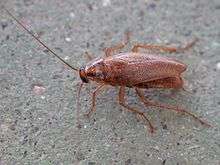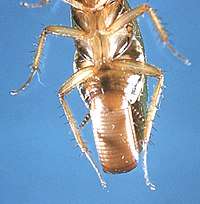German cockroach
The German cockroach (Blattella germanica) is a small species of cockroach, typically about 1.1 to 1.6 cm (0.43 to 0.63 in)[1][2] long. In colour it varies from tan to almost black, and it has two dark, roughly parallel, streaks on the pronotum running anteroposteriorly from behind the head to the base of the wings. Although B. germanica has wings, it can barely fly, although it may glide when disturbed.[3] Of the few species of cockroach that are domestic pests, it probably is the most widely troublesome example.[4] It is very closely related to the Asian cockroach, and to the casual observer, the two appear nearly identical and may be mistaken for each other. However, the Asian cockroach is attracted to light and can fly like a moth, while the German cockroach cannot.
| German cockroach | |
|---|---|
 | |
| Scientific classification | |
| Kingdom: | Animalia |
| Phylum: | Arthropoda |
| Class: | Insecta |
| Superorder: | Dictyoptera |
| Order: | Blattodea |
| Family: | Ectobiidae |
| Genus: | Blattella |
| Species: | B. germanica |
| Binomial name | |
| Blattella germanica | |
Biology and pest status
The German cockroach occurs widely in human buildings, but is particularly associated with restaurants, food processing facilities, hotels, and institutional establishments such as nursing homes. In cold climates, they occur only near human dwellings, because they cannot survive severe cold. Though they would soon die in the outdoors on their own, German cockroaches have been found as inquilines ("tenants") of human buildings as far north as Alert, Nunavut.[5] Similarly, they have been found as far south as southern Patagonia.[6]
Previously thought to be a native of Europe, the German cockroach later was considered to have emerged from the region of Ethiopia in Northeast Africa,[7][8] but more recent evidence suggests that it actually originated in Southeast Asia.[4][9] Whatever the truth of the matter, the cockroach's sensitivity to cold might reflect its origin from such warm climates, and its spread as a domiciliary pest since ancient times has resulted from incidental human transport and shelter. The species now is cosmopolitan in distribution, occurring as a household pest on all continents except Antarctica, and on many major islands, as well. It accordingly has been given various names in the cultures of many regions.
Though nocturnal, the German cockroach occasionally appears by day, especially if the population is crowded or has been disturbed. However, sightings are most frequent in the evening, when someone suddenly brings a light into a room deserted after dark, such as a kitchen where they have been scavenging.[10] When excited or frightened, the species emits an unpleasant odor.
Diet
German cockroaches are omnivorous scavengers. They are attracted particularly to meats, starches, sugars, and fatty foods. Where a shortage of foodstuff exists, they may eat household items such as soap, glue, and toothpaste. In famine conditions, they turn cannibalistic, chewing at each other's wings and legs.[11] The German cockroach is an intermediate host of the Acanthocephalan parasite Moniliformis kalahariensis.[12]
Reproduction
The German cockroach reproduces faster than any other residential cockroach,[13] growing from egg to reproductive adult in roughly 50 – 60 days.[14] Once fertilized, a female German cockroach develops an ootheca in her abdomen. The abdomen swells as her eggs develop, until the translucent tip of the ootheca begins to protrude from the end of her abdomen, and by that time the eggs inside are fully sized, about 1/4 inch long with 16 segments. The ootheca, at first translucent, soon turns white and then within a few hours it turns pink, progressively darkening until, some 48 hours later, it attains the dark red-brown of the shell of a chestnut. The ootheca has a keel-like ridge along the line where the young emerge, and curls slightly towards that edge as it completes its maturation. A small percentage of the nymphs may hatch while the ootheca is still attached to the female, but the majority emerge some 24 hours after it has detached from the female's body. The newly hatched 3-mm-long black nymphs then progress through six or seven instars before becoming sexually mature, but ecdysis is such a hazardous process that nearly half the nymphs die of natural causes before reaching adulthood. Molted skins and dead nymphs are soon eaten by living nymphs present at the time of molting.[13]
Pest control
The German cockroach is very successful at establishing an ecological niche in buildings, and is resilient in the face of many pest-control measures. Reasons include:
- lack of natural predators in a human habitat
- prolific reproduction
- short reproductive cycle
- the ability to hide in very small refuges
- sexual maturity attained within several weeks, and
- adaptation and resistance to some chemical pesticides[15]
German cockroaches are thigmotactic, meaning they prefer confined spaces, and they are small compared to other pest species, so they can hide within small cracks and crevices that are easy to overlook, thereby evading humans and their eradication efforts. Conversely, the seasoned pest controller is alert for cracks and crevices where it is likely to be profitable to place baits or spray surfaces.
To be effective, control measures must be comprehensive, sustained, and systematic; survival of just a few eggs is quite enough to regenerate a nearly exterminated pest population within a few generations, and recolonization from surrounding populations often is very rapid, too.[11]
Another problem in controlling German cockroaches is the nature of their population behaviour. Though they are not social and practice no organized maternal care, females carry oothecae of 18-50 eggs (average about 32) during incubation until just before hatching, instead of dropping them as most other species of cockroaches do. This protects the eggs from certain classes of predation. Then, after hatching, nymphs largely survive by consuming excretions and molts from adults, thereby establishing their own internal microbial populations and avoiding contact with most insecticidal surface treatments and baits. One effective control is insect growth regulators (hydroprene, methoprene, etc.), which act by preventing molting, thus prevent maturation of the various instars. Caulking baseboards and around pipes may prevent the travel of adults from one apartment to another within a building.

As an adaptive consequence of pest control by poisoned sugar baits, a strain of German cockroaches has emerged that reacts to glucose as distastefully bitter. They refuse to eat sweetened baits, which presents an obstacle to their control, given that baits are an economical and effective means of control. It also is a dramatic illustration of adaptive selection; in the absence of poisoned sweet baits, attraction to sugars strongly promotes growth, energy, and reproduction; cockroaches that are not attracted to sugars take longer to grow and reproduce, whereas in the presence of poisoned sugared baits, sugar avoidance promotes reproduction.[16]
Comparison of three common cockroaches
| Roach | German cockroach | Oriental cockroach | American cockroach |
| Preferred temperature | 15–35 °C (59–95 °F)[18] | 20–30 °C (68–86 °F)[17] | 20–29 °C (68–84 °F)[18] |
| Nymphal development[lower-alpha 1] | 54–215 days (at 24–35 °C (75–95 °F))[17] | 164–542 days (at 22–30 °C (72–86 °F))[17] | 150–360 days (at 25–30 °C (77–86 °F))[17] |
| Lifespan | Around 200 days[17] | 35–190 days[17] | 90–706 days[17] |
| Able to fly? | Uncommon[lower-alpha 2][17] | No[17] | Yes[17] |
Genome
The genome of the German cockroach was published in February 2018 in Nature Ecology and Evolution.[19] The relatively large genome (2.0 Gb) harbours a very high number of proteins, of which most notably one group of chemoreceptors, called the ionotropic receptors, is particularly numerous. These chemoreceptors possibly allow the German cockroach to detect a broad range of chemical cues from toxins, food, pathogens, and pheromones.[19]
See also
- Blattellaquinone, a sex pheromone of the German cockroach
Notes
- Dependent on several factors, including temperature (significantly), sex, and nutrition.
- German cockroaches can glide, especially males, but powered flight is uncommon.
References
- Alan Weaving; Mike Picker; Griffiths, Charles Llewellyn (2003). Field Guide to Insects of South Africa. New Holland Publishers, Ltd. ISBN 1-86872-713-0.
- John A. Jackman; Bastiaan M. Drees (1 March 1998). A Field Guide to Common Texas Insects. Taylor Trade Publishing. pp. 28–. ISBN 978-1-4616-2291-8.
- William J. Bell; Louis M. Roth; Christine A. Nalepa (26 June 2007). Cockroaches: Ecology, Behavior, and Natural History. JHU Press. pp. 33–. ISBN 978-0-8018-8616-4.
- Xavier Bonnefoy; Helge Kampen; Kevin Sweeney (2008). Public Health Significance of Urban Pests. World Health Organization. pp. 35–. ISBN 978-92-890-7188-8.
- The insects and arachnids of Canada, part 14, The Grasshoppers, Crickets, and related insects of Canada and adjacent region
- Faúndez, E. I. & M. A. Carvajal. 2011. Blattella germanica (Linnaeus, 1767) (Insecta: Blattaria) en la Región de Magallanes. Boletín de Biodiversidad de Chile, 5: 50-55.
- Cory, EN; McConnell, HS (1917). Bulletin No. 8: Insects and Rodents Injurious to Stored Products. College Park, Maryland: Maryland State College of Agriculture Extension Service. p. 135.
- Hill, Dennis S. (30 September 2002). Pests of Stored Foodstuffs and their Control. Springer. pp. 145–146. ISBN 978-1-4020-0735-4.
- Eaton, Eric R.; Kaufman, Kenn (2007). Kaufman Field Guide to Insects of North America. Houghton Mifflin Harcourt. p. 62. ISBN 978-0-618-15310-7.
- Gary R. Mullen; Lance A. Durden (27 September 2002). Medical and Veterinary Entomology. Academic Press. pp. 33–. ISBN 978-0-08-053607-1.
- Rust, Michael K.; Owens, John M.; Reierson, Donald A. (30 November 1994). Understanding and Controlling the German Cockroach. Oxford University Press. pp. 388–. ISBN 978-0-19-534508-7.
- Amin, Omar M.; Heckmann, Richard A.; Halajian, Ali; El-Naggar, Atif; Tavakol, Sareh (2014). "Description of Moniliformis kalahariensis(Acanthocephala: Moniliformidae) from the South African Hedgehog,Atelerix frontalis(Erinaceidae) in South Africa". Comparative Parasitology. 81: 33–43. doi:10.1654/4664.1.
- Ebeling, Walter. "Urban entomology". Archived from the original on 17 July 2013. Retrieved 17 July 2013.
- {http://museumpests.net/wp-content/uploads/2014/03/German-Cockroach.pdf Museumpests.net Accessed July 15, 2015}
- Fardisi, Mahsa; Gondhalekar, Ameya D.; Ashbrook, Aaron R.; Scharf, Michael E. (2019-06-05). "Rapid evolutionary responses to insecticide resistance management interventions by the German cockroach ( Blattella germanica L.)". Scientific Reports. 9 (1): 1–10. doi:10.1038/s41598-019-44296-y. ISSN 2045-2322. PMC 6549143. PMID 31165746.
- Wada-Katsumata, A.; Silverman, J.; Schal, C. (2013). "Changes in Taste Neurons Support the Emergence of an Adaptive Behavior in Cockroaches". Science. 340 (6135): 972–5. Bibcode:2013Sci...340..972W. doi:10.1126/science.1234854. PMID 23704571. (summary at BBC News)
- Bassett, W.H. (12 October 2012). Clay's Handbook of Environmental Health. Routledge. p. 317. ISBN 978-1-135-81033-7.
- Harrison, Mark C.; Jongepier, Evelien; Robertson, Hugh M.; Arning, Nicolas; Bitard-Feildel, Tristan; Chao, Hsu; Childers, Christopher P.; Dinh, Huyen; Doddapaneni, Harshavardhan; Dugan, Shannon; Gowin, Johannes; Greiner, Carolin; Han, Yi; Hu, Haofu; Hughes, Daniel S. T.; Huylmans, Ann-Kathrin; Kemena, Carsten; Kremer, Lukas P. M.; Lee, Sandra L.; Lopez-Ezquerra, Alberto; Mallet, Ludovic; Monroy-Kuhn, Jose M.; Moser, Annabell; Murali, Shwetha C.; Muzny, Donna M.; Otani, Saria; Piulachs, Maria-Dolors; Poelchau, Monica; Qu, Jiaxin; Schaub, Florentine; Wada-Katsumata, Ayako; Worley, Kim C.; Xie, Qiaolin; Ylla, Guillem; Poulsen, Michael; Gibbs, Richard A.; Schal, Coby; Richards, Stephen; Belles, Xavier; Korb, Judith; Bornberg-Bauer, Erich (2018). "Hemimetabolous genomes reveal molecular basis of termite eusociality". Nature Ecology & Evolution. 2 (3): 557–566. doi:10.1038/s41559-017-0459-1. PMC 6482461. PMID 29403074.
External links
| Wikimedia Commons has media related to Blattella germanica. |
- German cockroach on the UF / IFAS Featured Creatures Web site
- German cockroach fact sheet from the Penn State Extension